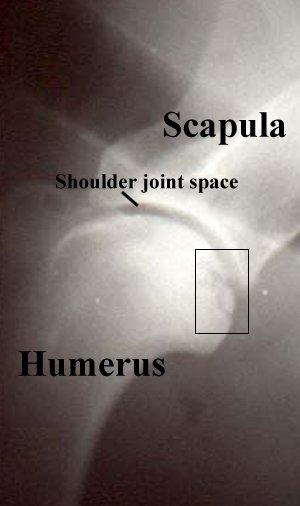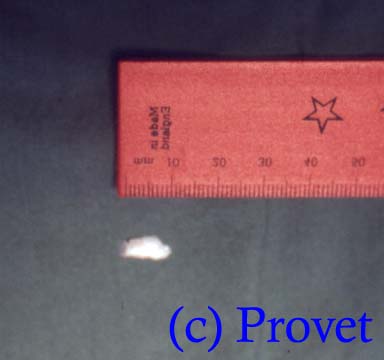 Back
Back
|
OSTEOCHONDROSIS AND OSTEOCHONDRITIS DISSECANS (or OCD) Note for Pet Owners:
This information is provided by
Provet for educational purposes only.
You should seek the advice of
your veterinarian if your pet is ill as only he or she can correctly advise
on the diagnosis and recommend the treatment that is most appropriate for
your pet.
Topics on this Page:
|
Description
Osteochondrosis is a generalised disease in which there is a
disturbance of normal cartilage formation during the growth of an animal.
Osteochondritis dissecans is the result of normal stresses or an injury to a joint that is affected with osteochondrosis resulting in cracks and fissures developing in the cartilage. This causes inflammation in the joint and to the underlying bone and separation of a flap of cartilage. This cartilage may be calcified and shows up on an XRay as a "joint mouse" . Later osteoarthritis (also called degenerative joint disease) develops in the joint.
In large and giant sized dogs osteochondritis dissecans is a major cause of osteoarthritis (also called degenerative joint disease) in later life.
In dogs the disease most often involves the following joints :
- Shoulder (affecting the head of the humerus)
- Elbow (affecting the medial condyle of the humerus)
- The stifle joint (affecting the condyle of the femur)
- The tarsus (hock joint) (affecting the tibial tarsal bone)
The disease may also affect :
- The radius (distal end next to the carpus) (one case report in a Dalmatian puppy)
- Vertebrae in the neck ("Wobbler" syndrome in Doberman Pinschers and Great Danes)
- The hip - based on OCD lesions having been found at other sites in some dogs with hip dysplasia and they also had OCD-type changes in the dorsolateral acetabular rim.
- Ununited anconeal process in the elbow
- Ununited (or fragmented) coronoid process in the elbow
- Legg Calve Perthes Disease of the hip
- Retained cartilage cores in the ulna (distal)
Cause
Th
- genetic factors
- nutrition (eg high calorie intake)
- trauma
- the occurrence of osteochondrosis is known to be associated with a fast rate of growth.
Breed Occurrence
Ostechondrosis affects many species including humans, poultry, pigs, cattle,
horses and dogs.
In dogs osteochondritis dissecans (or OCD) of the shoulder joint occurs in breeds that grow to be over 60lbs in body weight including the :
Afghan hound, Bernese Mountain Dog, Boxer, Dalmatian, Doberman Pinscher, English Setter, German Shepherd Dog, German Short-haired Pointer, Golden Retriever, Great Dane, Greyhound, Griffon (Wire-haired), Irish Setter, Irish Wolfhound, Labrador Retriever, Mastiff, Newfoundland, Old English Sheepdog, Pointer (English), Pyrenean Mountain Dog, Rhodesian Ridgeback, Rottwieler, Samoyed, Siberian Husky, St Bernard, Standard Poodle, and Vizsla .
Interestingly, osteochondritis dissecans has also been described in some smaller breeds including the :
Beagle, Border Collie, Cocker Spaniel, Miniature Poodle, Scottish Terrier, Springer Spaniel and Whippet
Osteochondritis dissecans of the medial condyle of the humerus in the elbow joint has been reported in the following breeds :
Bearded Collie, Chow Chow, German Shepherd Dogs, Golden Retriever, Labrador Retriever, Newfoundland, Rottweiler
Osteochondritis dissecans of the lateral (or sometimes medial) condyle of the femur in the stifle joint has been reported in the following breeds :
Border Collie, Boxer, Bull Mastiff, Chow Chow, Collie, Doberman Pinscher, German Pointer (wire-haired), German Shepherd, Giant Schnauzer, Great Dane, Greyhound, Irish Wolfhound, Labrador Retriever, St Bernard, Samoyed, Standard Poodle, Staffordshire Bull Terrier
Osteochondritis dissecans of the medial ridge of the tibial tarsal bone in the hock has been reported in the following breeds :
Australian Cattle dog, Bull Terrier, Golden Retriever, Irish Setter, Labrador Retriever, Queensland cattle dog, Rottweiler
Signs of osteochondritis dissecans in dogs usually occur at 5-10 months of age, and males are more often affected than females (3:1).
Signs
Th
e main signs of OCD in dogs are :- Some dogs may show no signs at all
- Stiffness
- Lameness - sudden onset, or gradual in onset
- The lameness is usually noticed in one limb first even though the disease is in more than one limb (50% are bilaterally affected)
- The lameness may improve with rest, and get worse with exercise
- The dog may have a shifting lameness if the disease is in both legs
- Manipulation of the joint may cause pain (eg extension or flexion of the joint)
- Manipulation of the joint may cause crepitus (a grating feeling within the joint)
- Abnormal posture - the dog may hold the limb away from the trunk of the body (called abduction)
Complications
- Muscle wastage around the affected joint
- Osteoarthritis
- Joint instability (OCD of the elbow)
Diagnosis
Diagnosis is confirmed by radiography, or advanced imaging techniques.
Osteochondritis dissecans of the shoulder joint. Loss
of bone density (grey-black lines) in the subchondral bone of the head of
the humerus are clearly visible, as is a defect and roughening of the
normal, smooth contour of the surface of the bone (in the box)
Diagnosis can be difficult in some cases
because :
More than one lesion may be present in a single joint at the
same time, for example OCD of the humerus AND ununited anconeal process may
occur together in the elbow joint Secondary changes due to osteoarthritis may mask the primary
problem of OCD Because multiple joints may be involved it is important to take
XRays of all susceptible joints even though the dog may only be lame on one
limb. Treatment
Most authors recommend surgery for osteochondritis to :

A cartilage flap ("joint mouse") removed from a dog with shoulder OCD
- Scrape and remove the diseased area of cartilage to promote healing
- To get an early return to normal function (2 months instead of 9-12 months for medical treatment)
- To minimise the severity of osteoarthritis developing in the joint later
However, some animals with mild disease have been successfully treated with medical therapy alone (rest and pain relief) and surgery is less likely to be totally successful if the OCD has been present for some time and signs of osteoarthritis are already present on radiographs.
Prognosis
Good if the disease is diagnosed and treated early
Long term problems
Chronic osteoarthritis (degenerative joint disease)
Updated October 2013